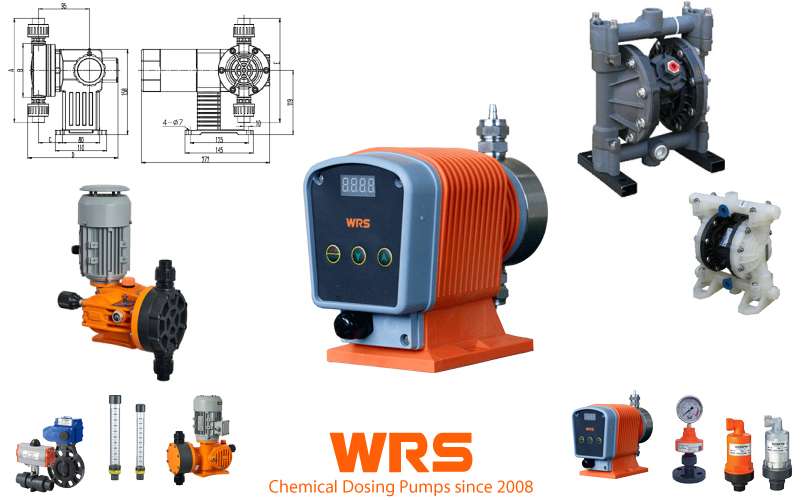
A dosing pump is a machine that enables the calculated dispersion of fluids such as water, gas, steam, chemicals and others. Although there are many different types and models of metering pumps are available on the market. The most used types of dosing pumps fall within certain type of categories (motor driven, peristaltic, solenoid and air operated diaphragm pump).
Each type of dosing pump is suitable for a different applications requiring different pressure range or certain chemicals to be metered.
Air Operated Diaphragm Pumps & Diaphragm Type With Constant Injection
This type of dosing pump offers pinpoint accuracy, ideal for range of fluids particularly high pressure dosing, WRS Diaphragm pumps are corrosive resistant and offers up to 80% more efficiency compared to others on the market
Diaphragm Pumps are used when constant and stable flow rates of a chemical is required for large bodies of treatable water. It consists of a pump chamber that is filled to the top in one go using a piston, control valves are placed on outlets and inlets. This type of dosing pump is excellent for instances when maximum flow rate is required
Peristaltic Pumps
Peristaltic pumps are also known as roller pumps and they are as their counterpart mentioned above, very accurate and specific. Their differing feature is a flexible and bendable tube for dispensing the chemical being used. The tube is often bent halfway or so and a mechanical lever shaped like a hand lets through a small portion of the chemical at a time.

This is helpful for industries such as medicine as purification and sterilization of each batch of chemicals becomes easier.
Furthermore, the bendable tube means it can easily be replaced as required which is normally done very frequently in the medical industry to keep things free from contamination.
The tube is also not necessarily plastic but can be rubber as well. These types of pumps, however, are quite useless for high temperature dosing of water, gas or steam and are hence not used for such purpose.
When using peristaltic pumps, the dosing pump is prepared by removing all the air from the inlets all the way to the injection point. An input signal or automated option or manual starting is used to begin the process upon carefully adjusting the dose. Once the process has started, the pump will keep working on those specifications until the signal is adjusted for a different flow rate.
Most dosing pumps regardless of their model do not require a lot of input or manual monitoring once they are set up with the right calibrations. If the product needs to be topped up, the dosing pump will usually sound an alarm and stop dispensation. This function is vital in its own right because it prevents untreated water or used chemical from traveling back up the pipe causing problems.
Pulse Injection Solenoid Driven Chemical Dosing Pumps
Diaphragm type pulse injection solenoid driven dosing pump utilizes a solenoid coil to dispense chemicals, it uses electromagnetic push rod driven diaphragm in the pump head reciprocating movement, causing the pump head chamber volume and pressure changes. The coil releases the chemical in bursts and this is its flow rate as it is calculated by the time lapse between each burst.

These pumps are also very easy to maintain and operate, therefore training specialized workers are needed less reducing the overall cost of operations particularly for large water treatment companies. For this reason amongst others, solenoid driven dosing pumps are preferred and used widely in a number of different industries.
Solenoid driven chemical dosing pumps are categorized under positive displacement pump family.
- Potable water treatment (metering of disinfectants and great for treating large bodies of water quickly). It is suggested that the treated water be relocated to a tank afterward where it can be double checked before being released. This is to check unmixed chemical and to measure the PH level of the water
- Cooling circuits (metering of corrosion inhibitors and biocides)
- Waste water treatment (metering of flocculants)
- Paper and Plastics industry (metering of additives)
Motor Driven Chemical Dosing Pump
The most common driving method by all chemical dosing pumps “motor driven”. WRS motor driven dosing pumps are engineered to be operated with the minimum input power while delivering high flowrate and high pressure performance. These type of dosing pumps are more robust, reliable and able to run on their own without supervision. Dosing pumps with mechanically actuated diaphragms can be used almost universally metering in low pressure ranges.

Adjustable flow-rate
The stroke length and stroke rate (in this case the motor speed) can be adjusted to alter the capacity of this pump. The rotation of the electric motor is stepped down by a worm gear and converted into a linear stroke movement by a cam. The slide rod transfers this stroke movement to the diaphragm in the dosing head. Two non-return valves prevent the feed chemical from flowing back during pumping.
The Motor Driven Metering Pumps Can Handle Wide Range of Substances
- Chemicals up to over 1,800 l/h
- Disinfectants in potable water treatment and cooling circuits
- Flocculants in waste water treatment
- Additives in the paper industry and plastic manufacturing
Get More Than Just a Metering Pump
Got any questions about different types of dosing pumps and their application in detail? As you would agree that manufacturing Chemical Dosing Pumps since 2008 and serving over 50 countries worldwide means that you won’t be dealing with yet another
chemical dosing pump and systems supplier. Instead, speak with our industry experts who are ready to answer all your questions, listen to your requirements and provide options to get
reliable, effecient and cost effective solutions.
